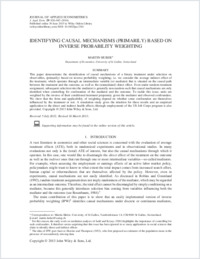Identifying causal mechanisms (primarily) based on inverse probability weighting
- Huber, Martin Department of Economics, University of St Gallen, Switzerland
-
2014
Published in:
- Journal of Applied Econometrics. - 2014, vol. 29, no. 6, p. 920-943
English
This paper demonstrates the identification of causal mechanisms of a binary treatment under selection on observables, (primarily) based on inverse probability weighting; i.e. we consider the average indirect effect of the treatment, which operates through an intermediate variable (or mediator) that is situated on the causal path between the treatment and the outcome, as well as the (unmediated) direct effect. Even under random treatment assignment, subsequent selection into the mediator is generally non-random such that causal mechanisms are only identified when controlling for confounders of the mediator and the outcome. To tackle this issue, units are weighted by the inverse of their conditional treatment propensity given the mediator and observed confounders. We show that the form and applicability of weighting depend on whether some confounders are themselves influenced by the treatment or not. A simulation study gives the intuition for these results and an empirical application to the direct and indirect health effects (through employment) of the US Job Corps program is also provided. Copyright © 2013 John Wiley & Sons, Ltd.
- Faculty
- Faculté des sciences économiques et sociales et du management
- Department
- Département d'économie politique
- Language
-
- English
- Classification
- Economics
- License
- License undefined
- Identifiers
-
- RERO DOC 323028
- DOI 10.1002/jae.2341
- Persistent URL
- https://folia.unifr.ch/unifr/documents/307042
Statistics
Document views: 97
File downloads:
- identifyingcausalmechanismsprimarilybasedoninverseprobabilityweightingjournalofappliedeconometrics296920-9432014_0.pdf: 419
